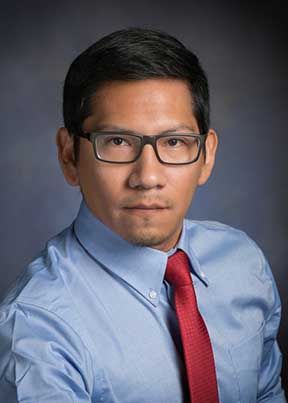Investigation of the Dynamic Terrestrial Hydrogen Exosphere
Dr. Gonzalo Cucho-Padin
Postdoctoral Researcher
NASA Goddard Space Flight Center
The Catholic University of America
Wed, November 8, 2023 - 4:00 PM
 The Earth's exosphere is the uppermost region of the terrestrial atmosphere and extends from 500 km (the exobase) up to 60 Earth Radii (RE). In this vast region, the most abundant component is atomic hydrogen (H). Knowledge of the three-dimensional (3-D) density distributions of H and its temporal evolution allows us to understand the planetary atmospheric evolution, investigate its role in dissipating geomagnetic energy from storm-time ring current, and provide support in interpreting magnetospheric images derived from Energetic Neutral Atoms (ENA) and Soft X-ray emissions. In this work, we show estimations of H density distributions derived from measurements of its far-ultraviolet emission (at 121.6 nm) acquired by the Lyman Alpha Detectors (LADs) onboard NASA's TWINS mission and the Lyman Alpha Imager CAmera (LAICA) onboard the Japanese PROCYON mission. We use a robust tomographic/deconvolution technique that leverages the linearity between the H density and its emission in the optically thin region, i.e., beyond 3 Earth Radii. The continuous data acquisition carried out by TWINS/LADs instruments enabled the estimation of time-dependent, global H density distributions during storm-time. We present our preliminary results of reconstructions during two strong geomagnetic storms which reveal significant H enhancements at geocentric altitudes of ~3RE during the main phase of the storm. The single image acquired by the PROCYON/LAICA instrument provides unprecedented visualization of the terrestrial exosphere in 121.6 nm that extends beyond 50 RE. We present a 3-D reconstruction of the H densities derived from this dataset and conduct a comparison study with radiance observations. We found that the H 3-D structure exhibit and elongated shape along the Sun-Earth axis which is in good agreement with the effect of the constant solar radiation pressure over the exosphere.
The Earth's exosphere is the uppermost region of the terrestrial atmosphere and extends from 500 km (the exobase) up to 60 Earth Radii (RE). In this vast region, the most abundant component is atomic hydrogen (H). Knowledge of the three-dimensional (3-D) density distributions of H and its temporal evolution allows us to understand the planetary atmospheric evolution, investigate its role in dissipating geomagnetic energy from storm-time ring current, and provide support in interpreting magnetospheric images derived from Energetic Neutral Atoms (ENA) and Soft X-ray emissions. In this work, we show estimations of H density distributions derived from measurements of its far-ultraviolet emission (at 121.6 nm) acquired by the Lyman Alpha Detectors (LADs) onboard NASA's TWINS mission and the Lyman Alpha Imager CAmera (LAICA) onboard the Japanese PROCYON mission. We use a robust tomographic/deconvolution technique that leverages the linearity between the H density and its emission in the optically thin region, i.e., beyond 3 Earth Radii. The continuous data acquisition carried out by TWINS/LADs instruments enabled the estimation of time-dependent, global H density distributions during storm-time. We present our preliminary results of reconstructions during two strong geomagnetic storms which reveal significant H enhancements at geocentric altitudes of ~3RE during the main phase of the storm. The single image acquired by the PROCYON/LAICA instrument provides unprecedented visualization of the terrestrial exosphere in 121.6 nm that extends beyond 50 RE. We present a 3-D reconstruction of the H densities derived from this dataset and conduct a comparison study with radiance observations. We found that the H 3-D structure exhibit and elongated shape along the Sun-Earth axis which is in good agreement with the effect of the constant solar radiation pressure over the exosphere.
Refreshments served at 3:45 PM
If you have any questions about the Colloquium Series or would like to make a donation please contact the Physics Department, cua-physics@cua.edu or (202) 319-5315.
